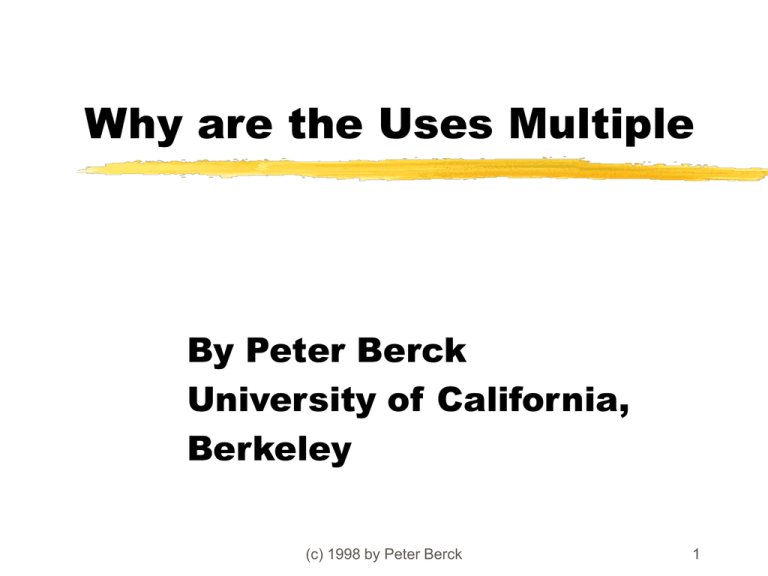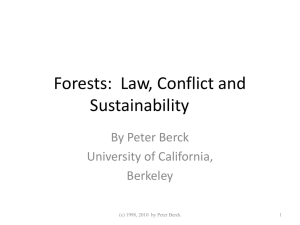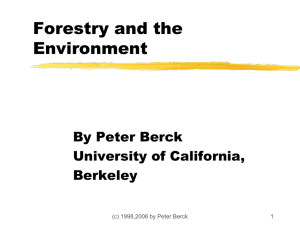
Why are the Uses Multiple
By Peter Berck
University of California,
Berkeley
(c) 1998 by Peter Berck
1
Goals
This is the story of shifting goals and the
effect they have on multiple use planning.
Planning history in PNW
Politics and Planning
Implications for planning
Stochastic
Mapping
2
Multiple Use is
Unavoidable
Water quantity insensitive to management
but quality can be affected by management
Recreationalists can’t be excluded
but can be encouraged with facilities
Wildlife lives there anyway
but clearcuts favor game; no cuts favor owls
3
Multiple Use: Which Use
Shall Be Master
American Politics drives multiple use
management in the forests of the West.
There are three distinct political and
management regimes: Pre, During, and
Post Owl
Management tools adapt to the politics
Management plans adapt to the politics:
Does the planner matter?
4
Postwar and Pre-Owl
Political agreement on timber
Informal tools--discretion
5
Planning: Old Style
Planner
professional forester
knowledge of resource
Owner
preferences over uses
supplies capital
Planning job
determine preferences
determine budget
find best plan among
feasible plans
easily amenable to
programming
formulation, but there
was no need to do so!
6
The Catch
The catch was that there needed to be an
owner. A close substitute would be wide
consensus on the appropriate goals and a
political willingness to let the planner
determine the goals within that
consensus.
Before ~1970, management of the
Forests was not so contentious.
7
Multiple Use Sustained
Yield Act of 1960
Multiple Uses
recreation
range
timber
watershed
wildlife
fish
(later wilderness is added)
No one use is to
predominate
“High level annual …
output
without impairment of
the productivity of the
land”
8
Agency Freedom
The USFS had ample latitude to operate
forests as it wished under MUSY of 1960.
The act codified what USFS was doing
anyway.
The Agency was trusted and political
consensus was pretty high.
This was easy because there were
substantial areas untouched by cutting.
9
Old Stated Objectives
Community Stability:
JOBS
coincident with mill
profits
Supply of Fiber (that’s
wood)
Recreation
Game and Fish
Scenic Drives
Hiking
Went together:
More wood is more
jobs is
more open forest
is more game
10
Wilderness Act (1964)
FS had designated wilderness on its own
and was now constrained by law on those
areas.
Forced to study additional lands for
inclusion.
Large single purpose reserves went
against the Multiple Use grain.
The Planner would not decide which lands
to reserve
11
Politics and Formalized
Planning
Oddly played out through acts thought to
innocuous or planning acts
National Environmental Policy Act
Endangered Species Act
Resource Planning Act
12
NEPA
Before a major federal action can be taken,
the agency must
Get public comment on issues to be considered
Make a plan (Environmental Impact Statement)
and several alternative plans
Get public comment on the plans
Choose a preferred alternative
This was not thought to be radical legislation.
13
Resource Planning Act (‘74)
Resource assessment at the National level
Targets for Regions and Forests
Plans to meet those targets
This act was a way for the FS to get long
term agreement by Congress on goals and
for the Industry to get a clear mandate to
produce wood.
14
RPA Didn’t work
Environmentalists wanted more wildland
than the FS was planning for.
Monongahela Decision: Resurrected
language in 100 year old law that made it
necessary to consider each tree before
cutting.
Clear need for new legislation
15
National Forest
Management Act (1976)
Political compromise
Non-declining flow
meant to preserve oldgrowth
would only delay cut out
CMAI
meant to put teeth into sustained yield
ecologically meaningless: trees still too small
16
Endangered Species Act
Can’t take animal, even on private land
Take includes remove habitat
Must list habitat to be protected
Leads to legal question: when does
regulation become confiscation of property?
Current answer is when no economic use possible
17
Participation
RPA
Interdisciplinary Teams (Regs. Restored
supervisors power)
Public comment
Full written disclosure to public
ESA
Public right to sue to protect animals
Public could see and could sue
18
Formal Planning
Under NFMA and RPA, formal planning for
multiple use was carried out by linear
programming.
The basic idea was to maximize present
value of timber, subject to CMAI, nondeclining flow, and other constraints.
The Spotted Owl became the most
celebrated constraint
19
SimpleForest Planning
Type of Site, j
Many “birthdays”
hj(t,s)
t is calendar time
s is birthday of stand
h is acres harvested
Dj(t-s) is volume per
acre
v(t) is cut at t
v=j s Dj(t-s) hj(t, s)
Max present value
of P times V
s.t. biology
v(t+1) v(t)
t-s > CMAI or h = 0
20
Biology
Initial Acres = Cut
over all time
Aj(s) = t hj(t,s)
Cut acres regrow and
are recut
s hj(t,s)
=
a hj(a,t)
W is what is left
standing
Aj(s) - t hj(t,s)
or =s hj(t,s) - a hj(a,t)
wj(s,t) =
This is Johnson and Scheurman, Model II.
21
More meaning to the
model
Types of sites, j
different species
site classes
critical locations
near streams
visual buffers
More Constraints
Don’t cut type j
Keep N% of forest at
age, t-s, > 100
constraint on w
More treatments
commercial thin
pre-commercial thin
22
Traditional Problems with
Planning
Find the Cut
Plans were not spatial
Foresters still had to
designate specific
parcels to be cut
Hard to see
cumulative effect of
decisions because of
mapping technology
The problem (Hrubes)
The cuttable land
base was much
smaller than the
planned land base
because of streams,
Indian burial grounds,
needed habitat, etc.
Difference only
discovered when
“finding the cut”
23
Allowable Cut Effect
To get nondeclining
flow
cut oldgrowth now
plan to cut
unprofitable trees later
When later comes,
make new plan and
don’t cut remote trees
Thus cut declines
under non-declining
constraint.
Industry likes this.
They get more wood
Environmentalists
hate this. They see
oldgrowth cut down
sooner.
It is an example of
“no commitment”
24
Forest Plans Took Forever
Not innocent: Old plans used while
waiting.
Once it was clear that the plans would call
for less timber, industry and Republican
administration did not want plans to be final
Environmentalists obliged by obstructing
plans for their goals.
(graphic on how much plans did to cut)
25
Spotted owl habitat
Goshawk habitat
Visual retention
Partial Visual ret.
Bald eagle habitat
Semi-primitive
WILD AND SCENIC RIVER
RECREATION AREA
Minimal management
Private Land
Timber emphasis
26
Owl Lead-up
FS released draft EIS on owl in August of
1986, 5% cut reduction
Final EIS April 1988, little less than 5%
ASQ reduction
But, this wasn’t enough to comply with
the law to protect the Owl, which wasn’t
even yet officially “threatened”
http://www.sweet-home.or.us/forest/owl/index.html
Injunction
March, 1989. Order restraining the FS
from offering 139 planned sales.
Yaffee (Wisdom of the Spotted Owl) takes
this as the pivotal action
There was a FS owl plan before this
Point at which the Owl became primary
28
Listing of the Owl
June 1989, proposed listing of Owl as
threatened in Fed. Register
June 1990 listed, but no critical habitat
29
Congress in the Act
No stranger control
Non-sustainable ASQ
as far back as Carter
1984 Bailout
Because of inflation,
companies bid too
much for timber;
Congress released
them from their
contracts withou full
penalties.
Hatfield-Adams
1989. Prescribed the
sale for (fiscal)‘89-’90
9.6 billion bd ft
streamlined appeals-SEIS not subject to
judicial
no temp restrain or
prelim injunct on fisc
‘90 timber sales
deadlines for judicial
review; special masters
30
Interagency Scientific
Committee
Future Chief Thomas, a biologist and others
April 4 1990
Reduce harvest levels in owl area by 30-40%
31
Listing of Habitat May ‘91
Fish and Wildlife complies with ESA
(finally)
Takes ISC report and enshrines it in law
critical habitat 11.6 million acres
of which 3 million were private
Small administration counterattack
1992 G_d Squad exempts small number of
sales for BLM
32
FEMAT: Option 9
“ecosystem management plan,” holistic,
adaptive
Option 9 is response to summit in april ‘93
Timber: year 1, 2 b bdf; then 1.7 b bdf then
decline to near 1 billion in the long run so it
averaged to 1.2 b bdf over 10 years.
About 90% reduction from the all time highs
adaptive management
local communities and agencies
still protects owls
33
Presidents Forest Plan
Is Option 9
Less timber
More attention to “ecosystem”
Replaces the planner: Jack Ward Thomas
and now Mike Dombeck
Replacing the planning process: No more
Forplan
Maybe no role for programming
34
GIS is in.
Congress Sets Cut Directly
(again)
Salvage Ride (good for two years)r
Response to destructive fires
Response to declining cut
Under the logging provision, the U.S. Forest
Service is directed to double the cutting of
dead and dying trees in national forests over
the next 18 months. The agency would be
virtually unhindered by the Endangered
Species Act and other laws protecting wildlife,
and timber sales would be exempt from court
35
challenge. (Bee, JULY 27, 1995)
Murrelets
The marbled murrelet was listed as
threatened on October 1, 1992
It nests in older redwood trees.
Various species of trout and salmon are
also listed as endangered.
Endangered species also live on private
land.
36
The Murrelet lives in
the valuable timber. ESA
prohibits cutting. A Deal
for Headwaters in the
the works.
Map Copyright © 1998 California Resources Agency. All rights
reserved.
Headwaters Deal
US and State to buy Headwaters for $250
m (fed) + $130 m (state)
Agree to Habitat Conservation Plan for
rest of PL’s holdings.
Does the HCP enable of hinder PL?
Headwaters sold for less than market
Environmentalist complaint about Salmon
habitat continues
38
Stakeholder Processes
Get the interested parties into room
Bargaining in shadow of the law
ESA
Political power
Clausowitz: War is the continuation of
politics by other means
Republicans and Environmentalists ascendant
at same time
39
Quincy Library Group
Locals (Jobs/Timber/Fire) try to get Congress
to accept their view over
National Conservation Organizations
(Animals/Oldgrowth)
in planning for N. Sierra Forests
Big Issue is condition: Locals want thinning
to reduce fire risk
Is an “adaptive management” experiment
40
Making Sense of the
Record
Explain the outcome with Political
Economy
Find the implications for Planning
41
New Emphasis on Stock
Agency and Administration
Protect Wildlife per se (stock): owls and
Fish
Fire (stock): reduce hazard for wood and
for communities
Create “healthy,” “natural,” or “diverse”
forest (stock)
get back to pre-european conditions
42
Counterpoint
Republican and Congressional
JOBS (flow)
Timber (flow)
But, Jobs makes much better politics than
timber.
43
JOBS
Does timber produce Jobs?
Jobs per bd ft, but can only cut once
Not constant: factor demand (Sullivan)
Not constant over time: technical progress
Indirect jobs?
IMPLAN I/O work says yes
Stewart says little: transfer payments as
basic
Regression says no
44
An Economist makes
Sense of Politics
A Game
Median Voter
Money and Votes
Political Business Cycle
45
Environmentalists and
Timber Beast
Timber Beast R = argmaxR V(T(R) ,r+E)
where R is rotation age; T is timber quantity
r is interest rate and E is chance of expropriation
by regulation
Environmentalist lobbies for reservations of
timber,
E = argmax U(E,R, c(E))
where c(E) is the cost of achieving E
46
continued
In this framework there are two reasons
for the environmentalist to exercise
restraint in his lobbying: cost and the
adverse effect on current management
(R).
Chris Costello, unpublished 1998.
47
Median Voter (Shalit)
Assuming that preferences are single peaked
in commodity/amenity space and that voters
decide the allocation between these uses,
Shalit (unpublished 1976) uses the median
voter theorem to find the actual allocation.
He notes that the outcome is not pareto
optimal and shows how side payments can be
used to achieve a PO.
48
Money and Votes
(Peltzman, 1976)
Timber Beast wants gov’t to cut timber.
Cutting unpopular with voters.
Timber Beast donates money for political
campaigns.
Voters respond to campaigns
Beast gives politicians enough money to
overcome voter dislike of cutting.
49
Political Business Cycle
(Ken Rogoff)
Presidents last only four years till re-election.
That gives them a short time horizon and
induces a political business cycle. Take the
downturn at the beginning of term so that
the recovery will be well underway by reelection. The Senator from Washington (and
Idaho) needs rural votes. Shift timber harvest
to the present to buy votes even if there is a
severe restructuring later President’s plan
starts high and ends low.
50
Simple Stochastic View
Goals for timber, owls
TG, OG
V = min E t (T- TG)2 + b(O - OG)2 (1+r)-t
r is interest rate
b is price of owls relative to timber
s.t. biology, other constraints as before
Clinton’s selection of Option 9:
TG = 1.2 billion, long run; OG high.
Recent History: a shift in the goals
51
Two period Stochastic
V = min .5 {(T1-TG)2 + E b(O2 - OG2)2 (1+r)-1}
s.t. O2 = (O1 - T1) d +e
OG2 = OG1 + n
1 r db
G
G
T1*
O1d O1 T1
2
1 r d b 1 r
b
*
G 2
V 2 T1 T
d O1 T1* O1G
1 r
1
2
b
Var (e n )
1 r
52
Stochastic Lessons
The randomness in goals contributes to
an increase in regret in the same way that
randomness in the biological processes
do.
With a vacillation in goals from 1 to 10
billion bd ft., goal uncertainty could be
more costly than biological uncertainty.
53
Stochastic: The “simple”
Fire stochastically assigns acres to new
“birthdays” (Johnson et al in SNEP) without harvest
Trees don’t always go to the one year
older age class
Relation between Owls O and Habitat W
has random element and unknown
parameter
54
Stochastic: The Horror
The Goals GO and GT change with the
political winds.
In a linear quadratic system, the control
variables would be linear in the targets GO
and GT and the state variables. Thus the
control variables would exhibit the same sort
of random fluctuation as the targets.
55
Implications for Planning
The planning exercise will be done and
redone. No commitment to carrying out
the plans. Shift (for a while) with the
political winds.
old-growth dependent species on a one
way trip. Once the habitat goes, no later
plan can bring it back. They will lose out
a piece at a time.
The Planner will look like a fool.
56
Forward and Backward
The Biologist rules the roost. They will
plan with mapping tools to get the forest
condition that they want.
They will do it “by eye”
An optimization will be after the fact and
only on lands they do not consider
important.
GIS will drive LP and not vice versa.
57







